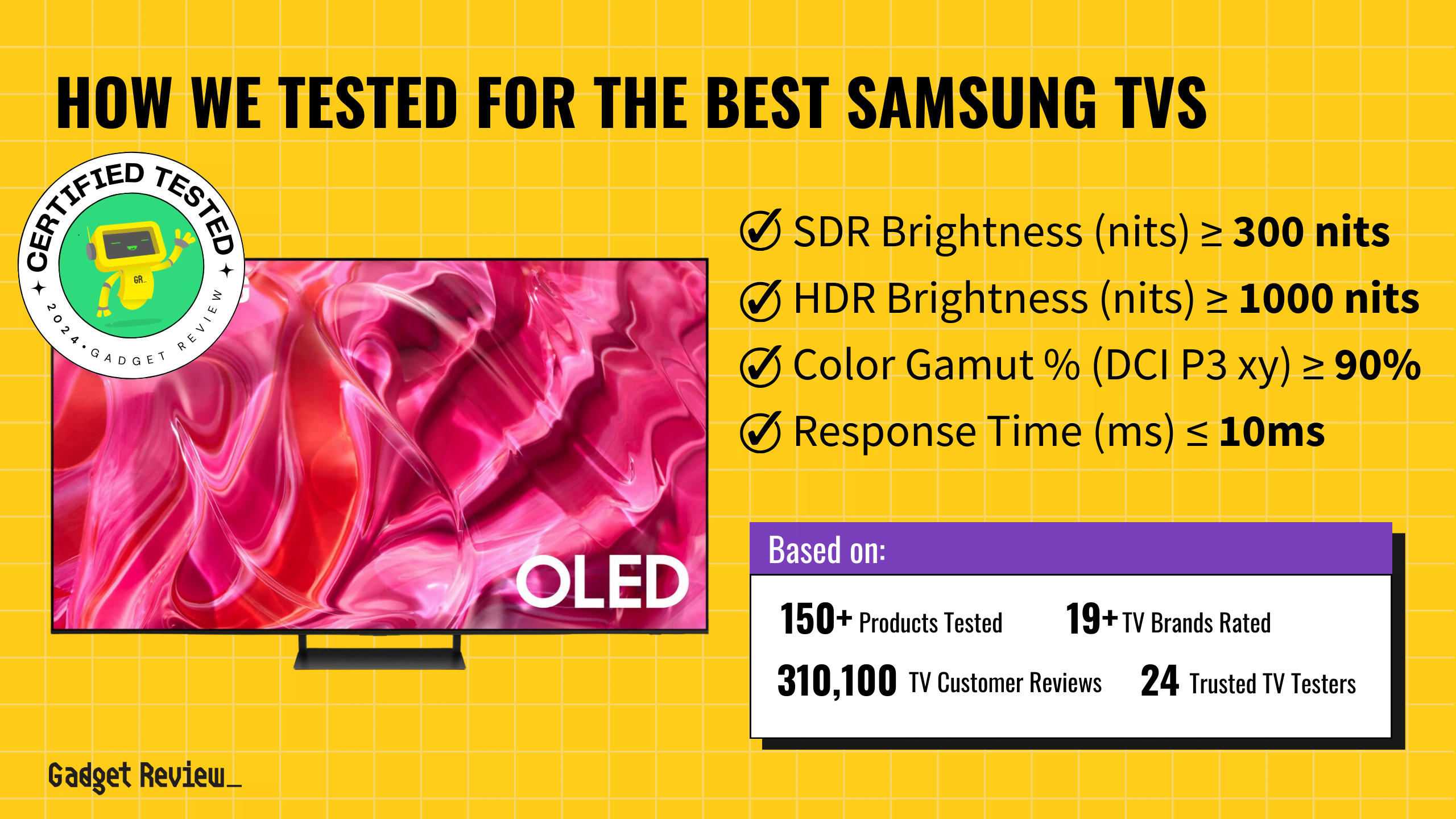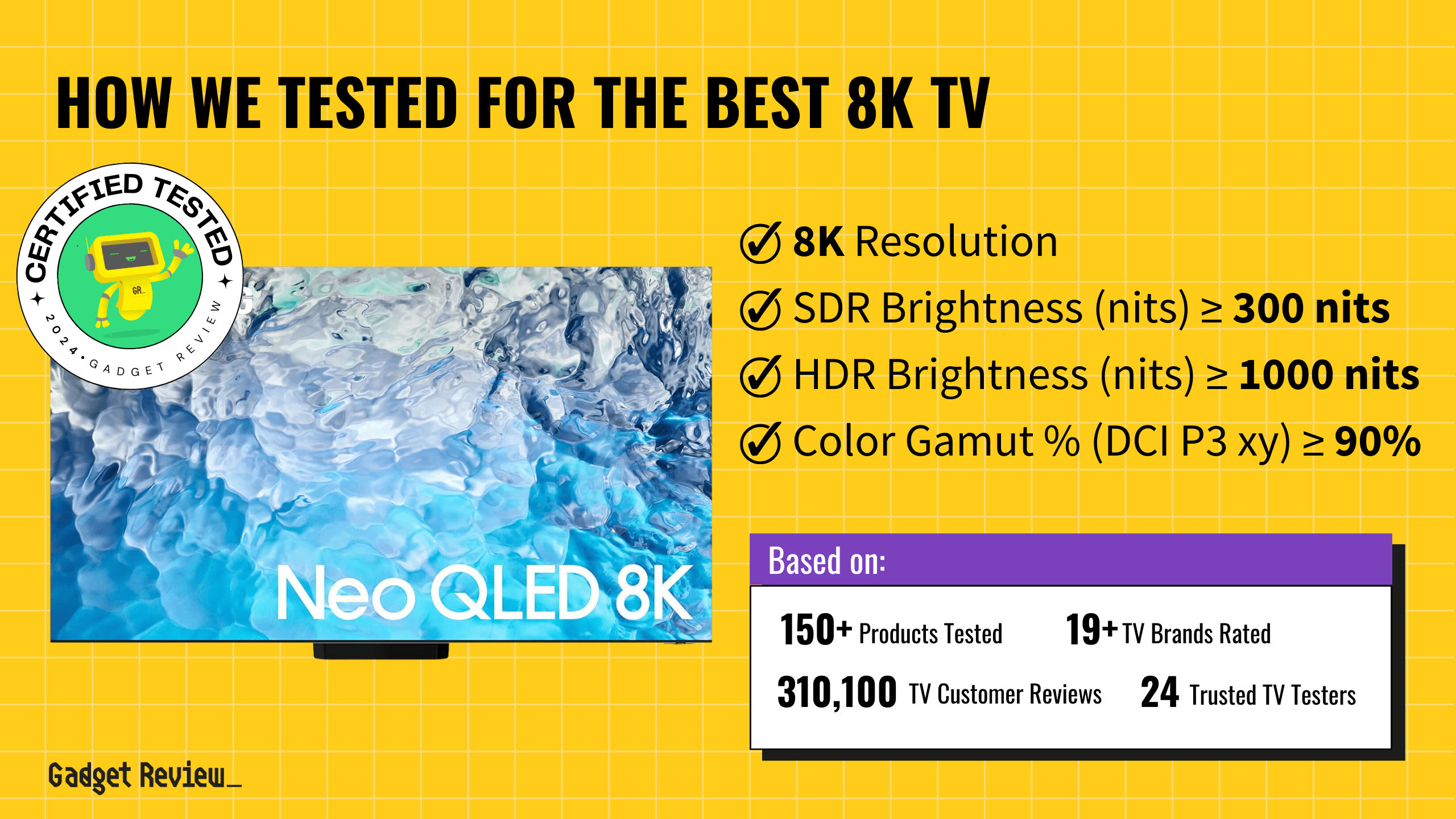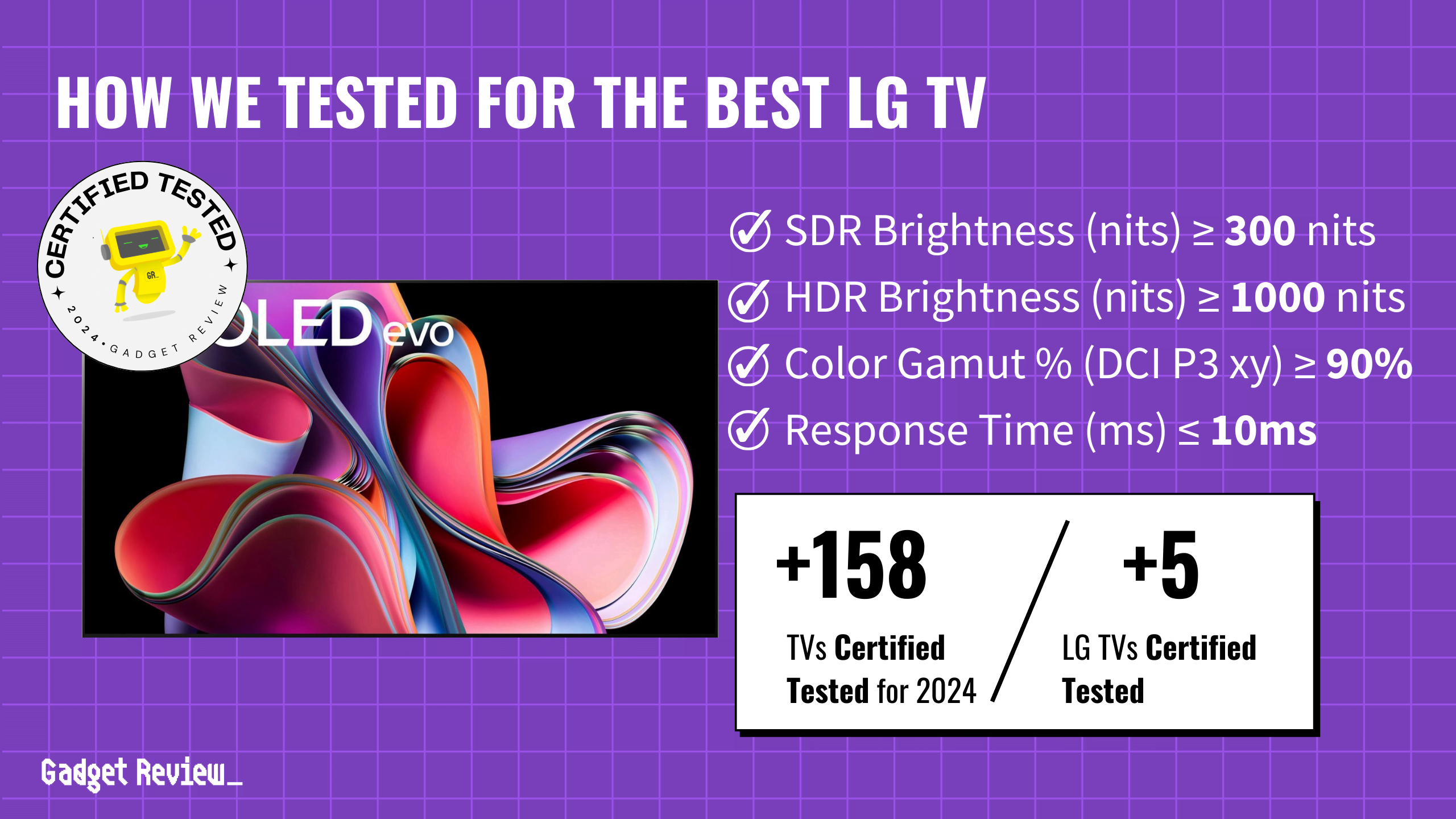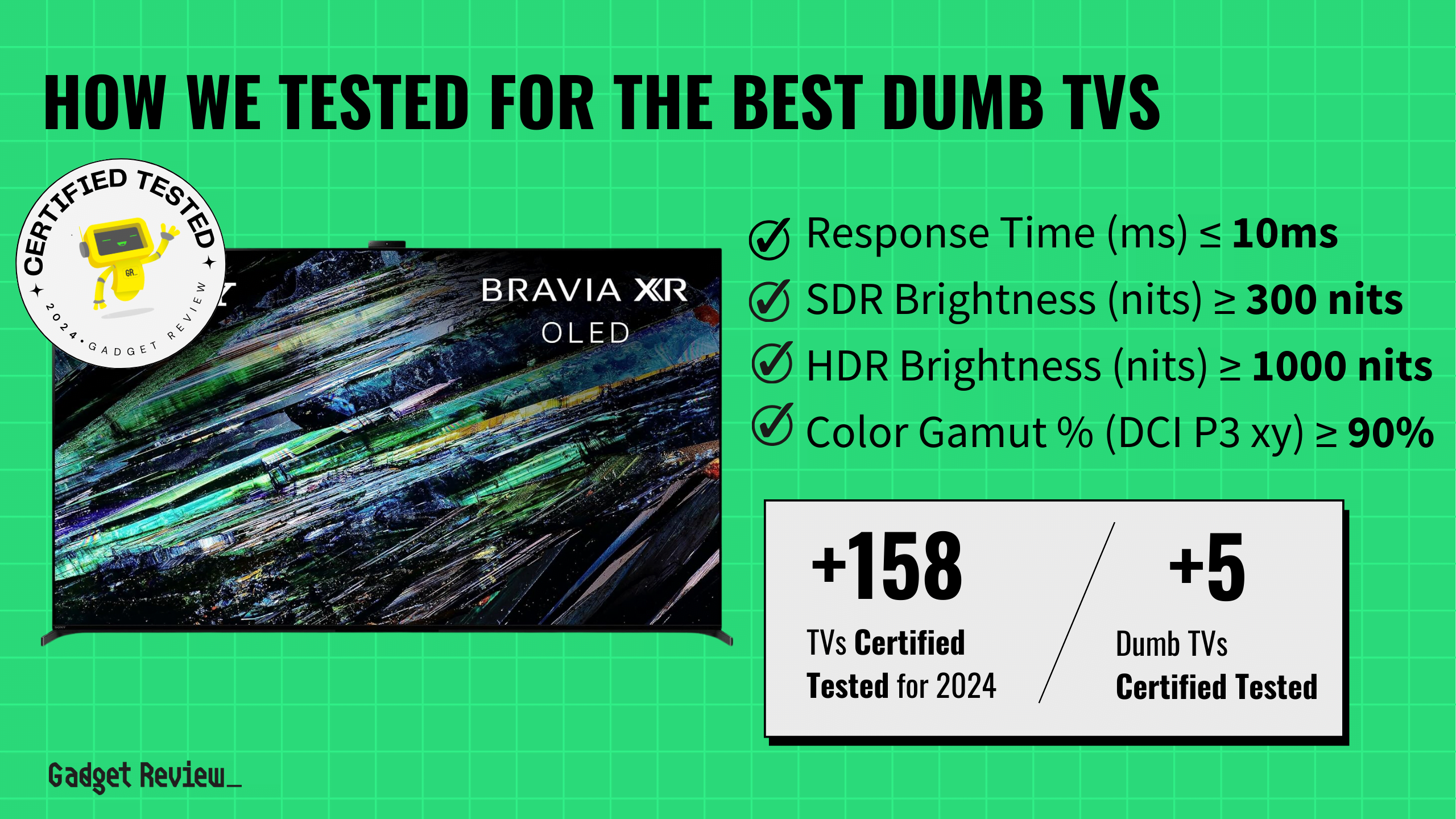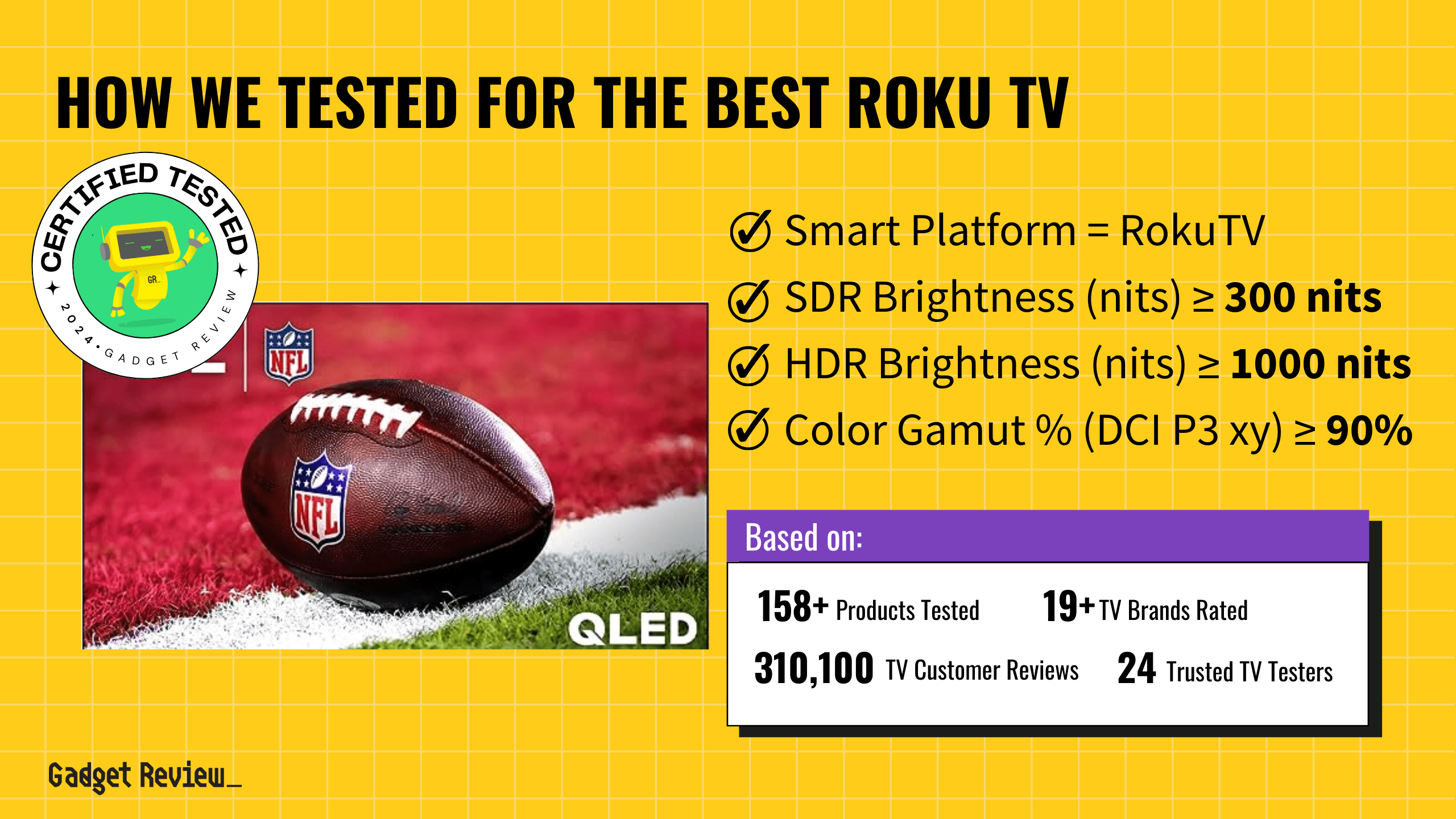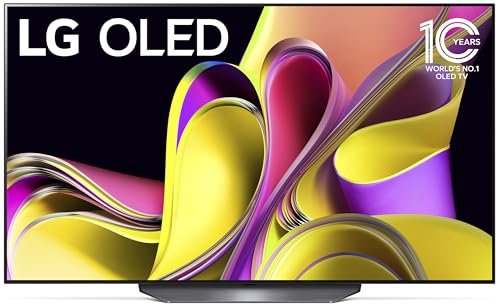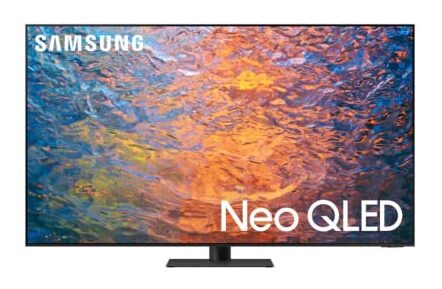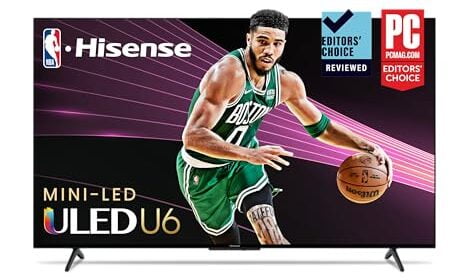Samsung TVs stand out for their versatility, backed by our comprehensive test data. Offering some of the best TVs on the market, Samsung caters to a wide range of preferences and uses. While they have premium options known for cutting-edge technology and exceptional performance, Samsung also offers great value buys that maintain quality.
Whether you’re drawn to the vibrant colors and deep contrasts of their QLED line or seeking a reliable, high-quality display within a more modest budget, Samsung delivers. Our test data-backed selections ensure you find a Samsung TV that not only meets your specific needs but also offers excellent performance and value.
How Did We Rank the Best Samsung TVs?
To assess how high or low quality a Samsung TV actually is, one must evaluate specific testing criteria against reference industry standards. Using our thorough TV Testing Methodology, we determined there are 6 criteria below (3 required, 3 nice to have) that ensure your content looks as good as the creator intended it.
Test Criteria
- SDR Brightness: Must be greater than or equal to 300 nits for a bright, clear picture in any light.
- HDR Brightness: Must be greater than or equal to 1000 nits, bringing out the detail in high dynamic range content.
- Color Gamut: Must cover at least 90% of DCI P3 xy color space, ensuring vibrant and accurate colors.
“Nice To Haves”
- Contrast Ratio: At least 10,000:1, for striking differentiation between light and dark areas.
- EOTF (600 nit delta): Less than or equal to 0.018, ensuring precise brightness and contrast transitions.
- Response Time: Should be no more than 10ms, keeping fast-paced action smooth and blur-free.
We’ve redefined TV buying guides, setting us apart from any other site on the planet. Our unique approach combines in-house verification with a comprehensive dataset from over 200+ trusted sites, focusing on key testing metrics to rank the top rated Samsung TVs. Testing data and specs include brightness (300 and 1000 nits), Color Gamut % (DCI P3 xy) >= 90%. In this case, it’s for Samsung TVs, addressing consumers’ needs for superior picture quality, vibrant colors, and optimal performance in any environment. Discover our data-driven methodology for precise, reliable TV recommendations.Our commitment to unbiased reviews is powered by our ‘True Score’ system, targeting low quality and fake reviews. Commissions fund this mission. No bias. No BS.
Latest Updates
- 03/06/2024: Completely and thoroughly overhauled the guide to include the best and latest Samsung TVs.
- 11/30/2023: Republished the list to include TVs based on our True Score system.
Top Best Samsung TVs For 2025
Prices accurate at the time of publishing
To snag a spot on our list, a Samsung TV needs to be capable of impressive color accuracy while providing excellent SDR and HDR brightness. If it doesn’t hit these points, we’re not including it!

Best Overall

Runner Up

Best Value

Best Budget

Best Mid-Range

Premium Pick
Samsung S90C TV
Best For Gaming
The Samsung S90C excels in color accuracy and response, offering top-notch OLED performance at mid-range pricing. Ideal for sports, gaming, and cinema, it’s the best value among Samsung TVs.
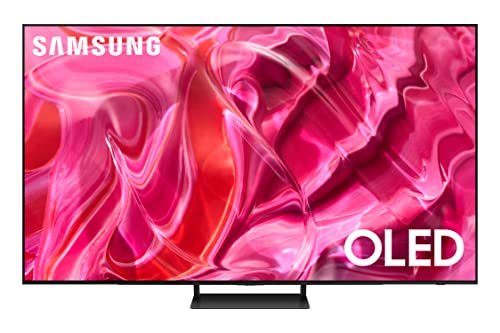
True Score
91948Experts
935kCustomers
Cosmic Wonder
 SAVE $500$1,499.99$999.99
SAVE $500$1,499.99$999.99Snapshot
Reasons to Buy
- Excellent picture quality
- The near-infinite contrast ratio for perfect blacks
- High peak brightness
- Exceptionally wide viewing angle
- Low input lag/Response time
- Sharp upscaling
Reasons to Avoid
- Aggressive Auto Brightness Limiter (ABL)
- No support for DTS or Dolby Vision
Specifications
Max Resolution 3840 x 2160 (4k) 
Backlight Type n/a Refresh Rate 120 Hz, 144 Hz Display Type OLED HDMI Inputs 4 
HDMI Type HDMI 2.1 HDR Format HDR10+, HLG 
HomeKit Compatible No 
Number of Audio Channels 2.1 
Panel Type OLED Screen size 55", 65", 75", 83" 
Smart Platform Tizen 
Speaker Output 40 Watts 
Sync Technology AMD FreeSync Premium 
VRR Yes All Specs
Test Results
SDR Brightness (nits) 373 HDR Brightness (nits) 1,058 Color Gamut % (DCI P3 xy) 99.975 Response Time (ms) 1.4 Contrast Ratio (x:1) 0 EOTF (600 nit delta) 0.0031 Color Gamut % (DCI P3 uv) 99.95 Color Gamut % (Rec 2020 xy) 86.37 Color Gamut % (Rec 2020 uv) 91.59 Color Gamut % (sRGB) 0 Color Gamut % (Rec 709) 0 Color Gamut % (BT.2020) 76 Color Gamut % (Adobe RGB) 0 Color Gamut % (BT.709) 0 Input Lag (ms) 8.5 Color Washout (Degrees) 70 Color Shift (Degrees) 70 Brightness Loss (Degrees) 70 Reflections (%) 1.2 Low-Freq Extension (Hz) 84.76 Freq Response StdDev @ 70db 2.8 Freq Response StdDev @ 80db 3.63 Weighted Total Harmonic Distortion @80db 0.133 Intermodulation Distortion @80db 2.47 EOTF (1000 nit delta) 0.0036 EOTF (4000 nit delta) 0.0024 All Tests
All Retailers
- $999.99$1,500Save $500
Availability
In StockFree Shipping
No - $1,134.95$1,197Save $62
Availability
In StockFree Shipping
No - $1,389.00$2,598Save $1,209
Availability
In StockFree Shipping
No
Our Verdict
The Samsung S90C OLED TV is an exceptional TV in Samsung’s overall lineup, and one of the very best TVs the brand has to offer thanks to its stellar performance and competitive pricing. Leveraging OLED technology, it delivers outstanding contrast and wide viewing angles, complemented by a nearly perfect color gamut of 99.98%, making it a phenomenal choice for vivid home theater content, sports and games.
While its SDR and HDR brightness levels at 373 nits and 1058 nits, respectively, put it behind its big brother, the S95C and well behind some of the QLEDs that Samsung offers, the S90C is still more than able to produce clear, vivid images. Its outstanding EOTF performance (coming in just barely behind the S95C) the S90C is able to accurately track gamma so that films are as close to what the mastering intended as possible.
If you’re a fan of live sports or competitive gaming, the S90C stands out with a best-in-class response time of 1.4 ms, ensuring motion is captured with exceptional clarity and without blur, enhancing the immersive experience of high-speed action. Coupled with an impressively low input lag of 8.5 ms, it offers a responsive, lag-free experience that will satisfy even the most demanding gamers looking for that competitive edge.
Overall, the S90C earns not only the top spot on our list, but also the title of Best Value, providing the greatest price to performance ratio. No matter what kind of content you throw at it, the S90C can handle it as long as the room it’s set up in isn’t too bright. If burn in is a concern however, you may want to consider a QLED from Samsung instead.

Best Overall

Runner Up

Best Value

Best Budget

Best Mid-Range

Premium Pick
Samsung S95C OLED TV
Best For Sports
With unmatched OLED brightness and phenomenal color gamut, the S95C is versatile enough for any setting. Though premium priced, it’s perfect for gamers and home theater enthusiasts seeking peak OLED performance.
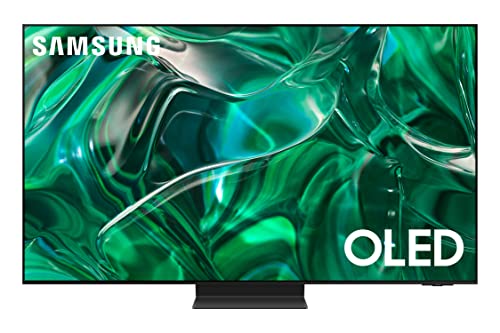
True Score
899215Experts
90723Customers
Absolutely Fresh
 SAVE $400$1,899.99$1,499.99
SAVE $400$1,899.99$1,499.99Snapshot
Reasons to Buy
- Excellent image quality
- Produces great bright colors and deep blacks
- Exceptionally wide viewing angle
- Incredibly low input lag
Reasons to Avoid
- Aggressive ABL
Specifications
Max Resolution 3840 x 2160 (4k) 
Backlight Type No Refresh Rate 120 Hz, 144 Hz Display Type OLED HDMI Inputs 4 
HDMI Type HDMI 2.1 HDR Format HDR10+, HLG 
HomeKit Compatible No 
Number of Audio Channels 4.2.2 
Panel Type QD-OLED Screen size 55", 65", 77" 
Smart Platform Tizen 
Speaker Output 70 Watts 
Sync Technology AMD FreeSync, AMD FreeSync Premium Pro 
VRR Yes All Specs
Test Results
SDR Brightness (nits) 704 HDR Brightness (nits) 1,383 Color Gamut % (DCI P3 xy) 99.81 Response Time (ms) 5.5 Contrast Ratio (x:1) 0 EOTF (600 nit delta) 0.0029 Color Gamut % (DCI P3 uv) 99.53 Color Gamut % (Rec 2020 xy) 84.99 Color Gamut % (Rec 2020 uv) 89.78 Color Gamut % (sRGB) 0 Color Gamut % (Rec 709) 141.5 Color Gamut % (BT.2020) 75 Color Gamut % (Adobe RGB) 0 Color Gamut % (BT.709) 0 Input Lag (ms) 8.3 Color Washout (Degrees) 70 Color Shift (Degrees) 70 Brightness Loss (Degrees) 70 Reflections (%) 1 Low-Freq Extension (Hz) 106.79 Freq Response StdDev @ 70db 2.45 Freq Response StdDev @ 80db 2.41 Weighted Total Harmonic Distortion @80db 0.511 Intermodulation Distortion @80db 0.511 EOTF (1000 nit delta) 0.0025 EOTF (4000 nit delta) 0.0022 All Tests
All Retailers
- $1,499.99$1,900Save $400
Availability
In StockFree Shipping
No - $1,499.00
Availability
In StockFree Shipping
No - $1,797.95
Availability
In StockFree Shipping
No
Our Verdict
Within the Samsung lineup, the S95C OLED TV is a standout TV at a premium price that offers exceptional color accuracy and luminance. This model boasts an outstanding 99.81% DCI P3 color gamut, coupled with unparalleled brightness levels—704 nits in SDR and a peak of 1383 nits in HDR. This ensures the S95C produces vivid and striking visuals in any lighting condition, making it a versatile choice for both immersive home theater setups and brightly lit living spaces.
The S95C’s performance is further enhanced by its 5.5 ms response time, which guarantees fluid playback for the dynamic movement found in movies and live sports. Additionally, its competitive 8.3 ms input lag makes it a preferred option for gamers looking for a TV that can keep up with fast-paced action without sacrificing performance.
Among Samsung’s OLED offerings, the S95C stands out for its EOTF performance, with a value of 0.0029, the best in its category. This ensures exceptionally accurate reproduction of home theater content, whether viewed in dimly lit rooms or areas with ample ambient light. While the S95C’s premium pricing places it at the higher end of the market, it remains an attractive choice for those willing to invest in a top-tier 65-inch TV experience, offering unparalleled adaptability and quality across a wide range of viewing scenarios.
DID YOU KNOW 87% OF TV REVIEWERS ARE UNTRUSTWORTHY?
Our research found 28 of 210 TV reviewers can be trusted, and shockingly 1 out of 3 on Google Page 1 were fake reviews showing no proof of test claims. See our Expose and Trust List. This is why Gadget Review is committed to calculating the most accurate product scores on the web.
To do this, we give every TV review site a Trust Rating, which measures how trustworthy the site and their testing claims are. We then leverage AI & a machine learning model to combine and calculate the Trust Rating with data from experts and consumers to deliver the True Score, the web’s most accurate product quality rating.

Best Overall

Runner Up

Best Value

Best Budget

Best Mid-Range

Premium Pick
Samsung QN90C NEO QLED Series
Best For Bright Room
The QN90C shines brightest in Samsung’s lineup, offering a burn-in free experience without sacrificing color and performance. Ideal for bright rooms and long gaming sessions, it’s a top QLED pick.
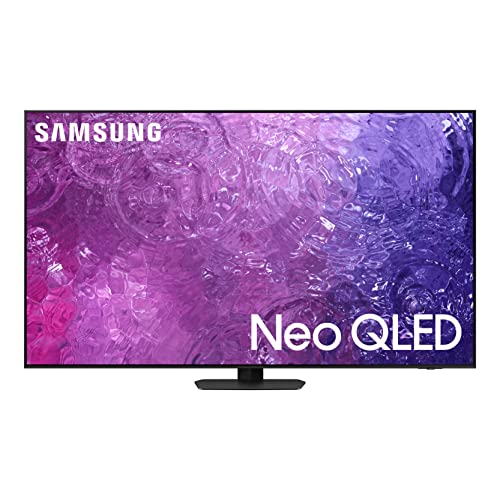
True Score
86859Experts
925kCustomers
Absolutely Fresh
 SAVE $1$1,299.99$259.99
SAVE $1$1,299.99$259.99Snapshot
Reasons to Buy
- Superb picture quality
- High brightness and contrast
- Low-tested response time and input lag
- High refresh rate and VRR support
Reasons to Avoid
- Moderate viewing angle
- Mild blooming
Specifications
Max Resolution 3840 x 2160 (4k) 
Backlight Type Full-Array Refresh Rate 120 Hz Display Type LED HDMI Inputs 4 
HDMI Type HDMI 2.1 HDR Format HDR10+, HLG 
HomeKit Compatible No 
Number of Audio Channels 4.2.2 
Panel Type Neo QLED Screen size 43", 50", 55", 65", 75", 85" 
Smart Platform Tizen 
Speaker Output 60 watts 
VRR Yes 
Works With Amazon Alexa, Bixby, Bluetooth, Google Assistant, Remote Control, SmartThings, Wi-Fi All Specs
Test Results
SDR Brightness (nits) 1,289 HDR Brightness (nits) 1,923 Color Gamut % (DCI P3 xy) 93.335 Response Time (ms) 10.2 Contrast Ratio (x:1) 83,200 EOTF (600 nit delta) 0.0046 Color Gamut % (DCI P3 uv) 93.64 Color Gamut % (Rec 2020 xy) 72.73 Color Gamut % (Rec 2020 uv) 75.69 Color Gamut % (sRGB) 98 Color Gamut % (Rec 709) 99.77 Color Gamut % (BT.2020) 73 Color Gamut % (Adobe RGB) 79.1 Color Gamut % (BT.709) 0 Input Lag (ms) 10 Color Washout (Degrees) 26 Color Shift (Degrees) 51 Brightness Loss (Degrees) 32 Reflections (%) 1.5 Low-Freq Extension (Hz) 100.79 Freq Response StdDev @ 70db 1.61 Freq Response StdDev @ 80db 2.38 Weighted Total Harmonic Distortion @80db 0.334 Intermodulation Distortion @80db 0.31 EOTF (1000 nit delta) 0.0046 EOTF (4000 nit delta) 0.0044 All Tests
All Retailers
- $259.99$1,300Save $1
Availability
In StockFree Shipping
No - $748.95
Availability
In StockFree Shipping
- $1,077.00$1,999Save $922
Availability
In StockFree Shipping
No - $1,297.95
Availability
In StockFree Shipping
No
Our Verdict
If burn-in is a concern you’d rather avoid, Samsung’s QN90C NEO QLED is not only exceptionally bright – far more than the OLEDs on our list – but also completely free of any kind of burn-in risk. Despite a color gamut of 93.34% DCI P3 xy that doesn’t quite match up with its OLED counterparts, its performance is notably impressive for a QLED, striking a fine balance between vibrant color representation and exceptional brightness. The QN90C puts out SDR and HDR brightness levels of 1289 nits and 1923 nits respectively, ensuring it outshines competitors especially in bright rooms where the competition would otherwise struggle.
Equipped with HDMI 2.1 and a 120Hz refresh rate, the QN90C is just as equipped to tackle modern gaming and fast-moving sports as its OLED brothers.Though the QN90C has the highest response time on our list at 10.2 ms, it’s still responsive enough for most sports watching and gaming content. If you’re a competitive gamer, the TV’s input lag of 10.0 ms is excellent and barely trails behind the S90C and S95C, all while being better suited to marathon gaming sessions, since the lack of burn-in means you don’t have to worry about your HUD permanently etching itself into your TV.
Home theater enthusiasts looking to set up a QLED in a more brightly lit home theater will appreciate the EOTF of 0.0046. It may be the highest delta in the lineup, but it still beats our minimum 0.0180 by a huge margin, meaning that the mastering and gamma tracking of HDR and film content is accurate. While the QN90C can’t compete with near-infinite contrast that OLEDs offer, the contrast ratio it has of 83,200:1 is still more than enough for deep blacks and rich contrast in dynamic scenes.
The only real downside to the Samsung QN90C NEO QLED is its pricing. Despite coming in behind its brothers in nearly every metric but brightness, it still costs as much as an S90C. However, the fact it’s much brighter means it’s much more suited to brightly lit rooms and if overcoming the sun is what matters most to you, the fact the QN90C is only slightly behind the OLEDs on our list is a point in its favor. It’s absolutely worth considering if you’re looking for near OLED performance without having to deal with dimmer brightness and burn-in risks.

DON’T SEE WHAT YOU’RE LOOKING FOR?
Like the top Sony TVs and high-end LG TVs, Samsung is one of the best TV brands. Consulting a TV buying guide can help you decide on the ideal TV if you have a particular use, such as the best gaming TVs or the best TV for sports. In addition, our selection of the best OLED TVs offers an exceptional viewing experience with deep blacks and vibrant colors, suitable for movie enthusiasts and gamers alike.
If you’re looking for versatility, our guide to the best TV monitors can help you find a model that fits both work and play. Moreover, for those seeking quality at a more accessible price point, our lineup of great Hisense TVs presents compelling options. Specifically, our Hisense H8G review highlights its impressive performance and value for budget-conscious consumers. And if you’ve already bought a soundbar, read our guide on how to connect a soundbar to your TV.

Our Approach to Testing Samsung TVs
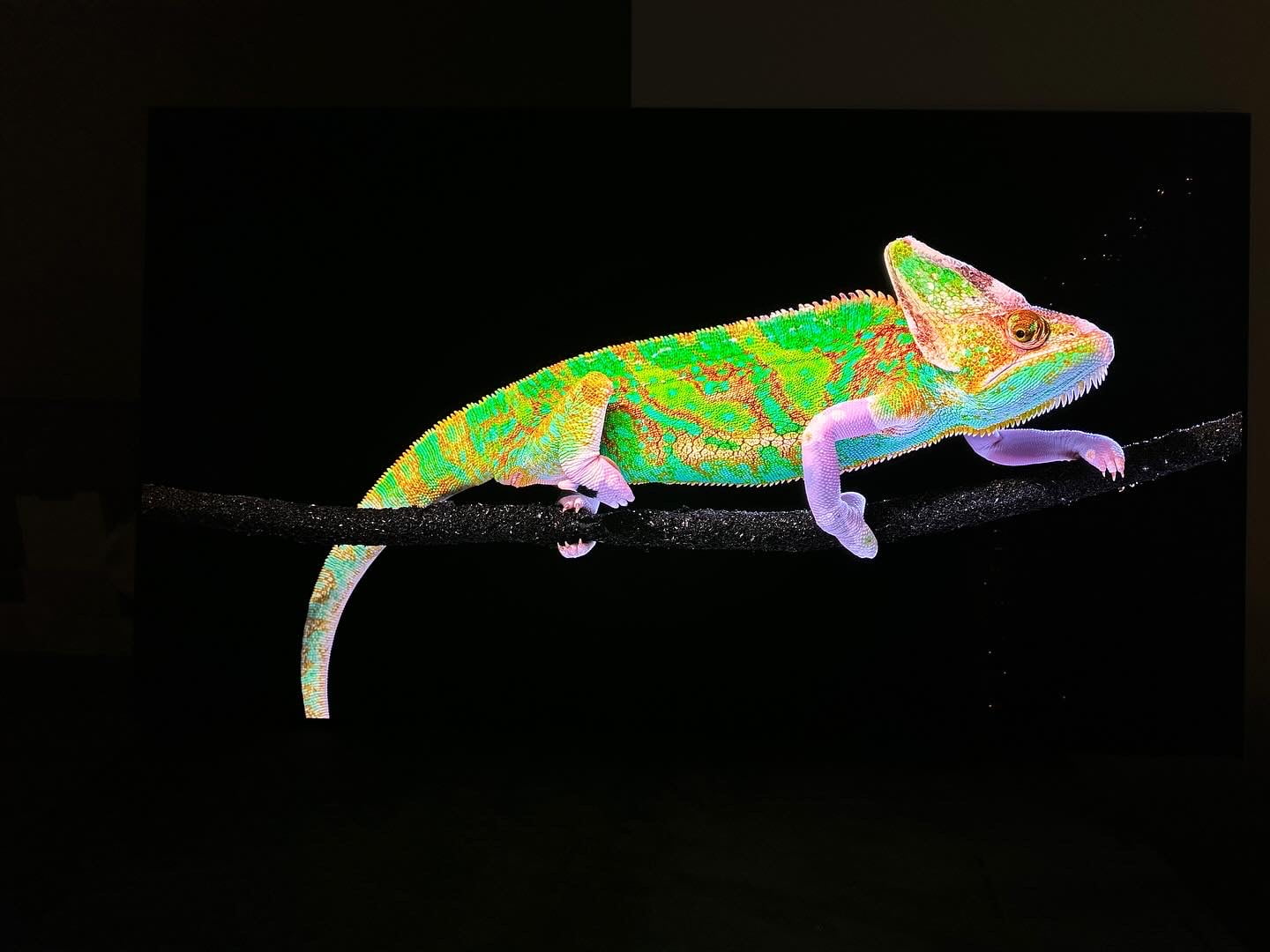
Evan Shepard/Gadget Review
Samsung TVs, backed by our comprehensive test data, offer top-tier performance and value. Whether you’re eyeing their premium models or seeking budget-friendly options, Samsung delivers versatility and quality. Our data-driven recommendations ensure you find the perfect Samsung TV, meeting your specific needs with excellence and value.
We collect this data so you don’t have to, simple as that. We then average that testing data to represent that Samsung TV’s capabilities accurately. Subsequently, we then leverage that data, filter and sort our buying guides, ensuring that all the Samsung TVs on our guides meet strict requirements.
You may notice some of our graphs contain “Source: RTings”. This is to indicate that the data we’re showing off in a graph has come from a single source – because it’s the only source that actually tested the criteria and had data for it! Normally, our data is an average out of all of the various publications that test and provide data to give you a good idea of how a product is going to perform on average.
Which Criteria Matters for Testing Best Samsung TVs?
By focusing on these criteria (3 required, 3 nice to have), anyone can quickly and easily compare these TVs and how they’ll perform. This helps you make an informed decision and purchase a TV that will fit into your small or tight space.
| CRITERIA | RANGE | REQUIRED | DEFINITION |
|---|---|---|---|
| SDR Brightness | 300+ nits | Yes | Assess the luminance of your display when operating in Standard Dynamic Range (SDR) mode. |
| HDR Brightness | 1000+ nits | Yes | Determine the luminance of your display in High Dynamic Range (HDR) mode. |
| Color Gamut (DCI P3 xy) | >= 90% | Yes | Evaluate the extent to which a TV can reproduce a specified spectrum of colors. |
| EOTF | 0.018 | No (nice to have) | Standard that governs how a display interprets and renders brightness and color. |
| Response Time | <=10ms | No (nice to have) | Time required for a pixel to transition from one color to another and then return to its original color. |
| Contrast Ratio | >= 10,000 | No (nice to have) | The ratio between the brightest white and darkest black that the screen can display. |
Our Trusted Data Sources
(Publication category Score is 80%+)
We looked at 210+ TV reviewers and while 24 are trustworthy (60%+ Trust Rating), we only use data from the testers that are “very trusted” which means a Trust Rating above 70%. The three we have listed below are our most trusted for TVs, along with our own in-house TV expert.
- Evan Shepard – Gadget Review
- Matthew Lopes – RTings, MuckRack
- Will Greenwald – PCMag, MuckRack, Twitter
- David Katzmaier – CNET, MuckRack, Twitter
Interested in a comprehensive analysis of our data sources? We’ve got you covered. Below, you’ll find a detailed list of every TV review website we’ve identified, organized by their respective Trust Ratings from highest to lowest. But we didn’t stop there. We’ve meticulously reviewed each publication and verified the data by checking whether the authors have bio links to MuckRack or LinkedIn. We’re committed to not only checking the facts but ensuring their veracity.
Best Samsung TVs Test Data & Results
1. SDR & HDR Brightness TV Test Results
In well-lit rooms, the brightness level of your Samsung TV, quantified in nits, is key to a great viewing experience. A TV that doesn’t meet the brightness requirement will struggle against natural and artificial light, resulting in a dim, lackluster image. Essentially, nits measure how well your TV can stand up to light interference, with higher values ensuring a sharper, more vivid display.
For standard viewing on the best Samsung TV, you should look for at least 300 nits to strike the right balance between clarity and color quality in standard dynamic range (SDR) content. For high dynamic range (HDR) content, which offers richer colors and greater contrast, a minimum of 1000 nits is ideal to truly appreciate the enhanced visuals. These brightness levels are recommended to ensure your TV performs well in bright settings, allowing you to enjoy your shows and movies without any loss in detail or quality. Aim for these minimums: SDR Brightness >= 300 nits; HDR Brightness >= 1000 nits for the optimal experience.
Discover the top Samsung TVs, ranked from brightest to least, all exceeding our brightness criteria.
Brightness
SDR: 300+ nits
HDR: 1000+ nits
Acceptable range of performance
Definition: Maximum brightness in a specified pattern size window. Most commonly measured in a 10% or 100% white window.
Units of Measurement: nits (alternatively cd/m²)
Tools to Measure: TV, luminance meter
Why It’s Important:
Brightness helps counter ambient light so that details and colors don’t wash out and get lost.
SDR Brightness (in nits, higher is better)
HDR Brightness (in nits, higher is better)
2. Color Gamut (DCI P3 xy) TV Test Results
Color Gamut
>= 90%
Acceptable range of performance
Definition: The TV’s capability to display a spectrum of colors.
Units of Measurement: % (color space coverage in percent)
Tools to Measure: Colorimeter
Why It’s Important:
Inaccurate colors compromise the authenticity of the content.
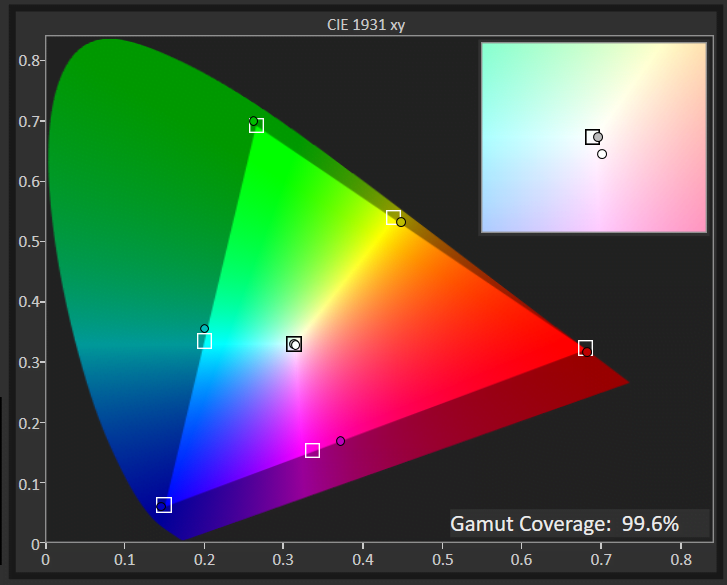
Color gamut defines the range of colors a Samsung TV can reproduce, directly affecting how vibrant and true-to-life the images look. A wide color gamut brings out richer, more vivid colors – from the lush greens of a garden to the bright colors of animated characters, enhancing your viewing experience to closely mimic real life.
This concept is technically measured against standards like the DCI P3 xy, a benchmark for high-quality visuals. A Samsung TV covering a higher percentage of this color space can display colors more accurately and vividly.
For those who prioritize vibrant and immersive visuals, aiming for a Samsung TV with a color gamut of 90% or higher on the DCI P3 xy scale is ideal. This ensures that the content you watch is as vibrant and lifelike as possible.
Below are the top Samsung TVs, ordered by color gamut, all exceeding our testing criteria.
DCI P3 XY Color Gamut (as a %; high is better)
3. EOTF Test Results
The Electro-Optical Transfer Function (EOTF) plays a critical role in ensuring the content on your TV looks exactly as the creator intended. This technical feature adjusts your screen’s brightness levels, ensuring every scene, from the darkest shadows to the brightest highlights, is displayed with true-to-life accuracy.
In rooms flooded with light, a TV that nails EOTF calibration shines by preserving the intended contrast and detail in the picture despite the challenging conditions. It balances the brightness so that images remain vibrant and full of detail, unaffected by the glare of ambient light.
A TV that excels in managing EOTF offers an immersive and authentic viewing experience. It brings creators’ visions to life, accurately rendering every scene with the proper light and dark levels, no matter the lighting in your room. This means you get a consistent, realistic picture that captures the full spectrum of colors and contrasts, from the subtlest hues to the most intense explosions.
Below are all the Samsung TVs on our list, ordered by EOTF, all exceeding our minimum requirement.
EOTF
< 0.018 (600 nit Δ)
Acceptable range of performance
Definition: How your TV interprets and renders the luminance data from content and translates it to be represented on screen. If EOTF/Gamma tracking is too low or too high, it will result in an over-brightened or over-darkened image from reference.
Units of Measurement: this test measures for the delta from the standard
Tools to Measure: Luminance colorimeter
Why It’s Important:
EOTF ensures that the game is displayed (color and HDR brightness) as the creator intended it
EOTF (source: rtings.com – 0 = no data exists; lower is better)
4. Response Time TV Test Results
Response Time
1ms-10ms
Acceptable range of performance
Definition: Speed at which a pixel transitions from one color to another
Units of Measurement: milliseconds (ms)
Tools to Measure: Screen, camera, test software
Why It’s Important:
A faster response time means less blur and thus more accuracy
A slow response time on a Samsung TV during fast-paced scenes is like trying to watch a thrilling movie with a foggy lens. Imagine settling in for an action-packed sequence, only to have the swift movements turn into a blur, robbing you of the crisp, clear detail you crave. This isn’t just a minor annoyance; it’s a major detriment to your viewing experience, leaving you with a picture marred by motion blur and visual artifacts.
So, what exactly is response time? It measures how quickly a pixel on your TV can change from one color to another. In the context of watching fast-moving content or enjoying dynamic scenes on a TV, a low response time is crucial. A response time of 15 ms or lower is good, but if you plan on gaming on this set, aim for a response time of 10 ms or lower. At these levels, your Samsung TV ensures smooth transitions and sharp visuals, making every scene come to life without any distracting blurs or delays.
Below are the top Samsung TVs, ordered by response time.
Response Time (in milliseconds; lower is better)
5. Contrast Ratio Test Results
For Samsung TV enthusiasts, a solid contrast ratio is crucial for enjoying your favorite TV shows or movies, especially in darker settings. This feature directly impacts how lifelike and dynamic the picture appears on your screen, ensuring that dark scenes are displayed with clear, crisp blacks instead of murky grays and bright scenes retain their detail without appearing washed out.
Put simply, the contrast ratio is all about the range of luminance a TV can produce, from the deepest blacks to the brightest whites. It’s what brings depth to the image, enhancing the realism of every scene. Watching a movie in the dark, for example, the difference between a TV with a poor contrast ratio and one with a high ratio is stark: the former struggles, blending shadows into a flat gray, while the latter delivers true black, making night scenes more immersive and detailed.
Ideally, a contrast ratio of 10,000:1 is what you should aim for in a Samsung TV. This level of luminance variance ensures that you’re getting a picture quality that can handle the nuances of lighting in any scene, providing a viewing experience that’s both rich and engaging. Note: OLED TVs have infinite contrast ratio, indicated by “0.”
Below are the top Samsung TVs, ordered by contrast ratio, all exceeding our testing criteria.
Contrast Ratio
>=10,000:1
Acceptable range of performance
Definition: Difference between the darkest black and the brightest white a screen can display.
Units of Measurement: cd/m2
Tools to Measure: Luminance meter
Why It’s Important:
A higher contrast ratio delivers deeper blacks, enhancing content definition, especially in darker rooms.
Contrast Ratio (higher is better)
Best Samsung TVs: Mistakes To Avoid
- Ignoring Compatibility: Failing to check compatibility with other devices or features like gaming consoles, streaming services, or sound systems can lead to frustration later on. As an example, the top Roku TV can seamlessly integrate with your existing devices not only prevents frustration but can help to enhance your entertainment experience.
- Overlooking Size and Space: Not considering the size of the room where the TV will be placed and the viewing distance can result in a TV that’s either too small or too large for comfortable viewing. A 75-inch TV is excellent for a large space, while one of the best small TVs would better suit your needs for smaller areas. Additionally, check out our Samsung the Frame TV review for a TV that doubles as artwork when you aren’t watching shows to keep your space aesthetically pleasing.
- Neglecting Picture Quality: Not paying attention to factors like resolution, HDR capability, and color accuracy can result in a subpar viewing experience. Additionally, understanding the differences between screen technologies such as QLED and LED can greatly impact your decision, especially when comparing TCL TVs models.
- Forgetting Future-Proofing: Buying a TV without considering future technological advancements or features may lead to early obsolescence. For instance, just as 4K overtook 1080p TVs, eventually, the best 8k TVs will overtake the top 4K TVs. Check out our comparison of 4K vs 8K to learn more about these differences.
The Best Samsung TVs Tests Compared
Product |
True Score
|
SDR Brightness
|
HDR Brightness
|
Color Gamut
|
EOTF
|
Response Time
|
Contrast Ratio
| |
|---|---|---|---|---|---|---|---|---|
| 91 |
|
|
|
|
|
| |
| 89 |
|
|
|
|
|
| |
| 86 |
|
|
|
|
|
| $1,097.99 |


